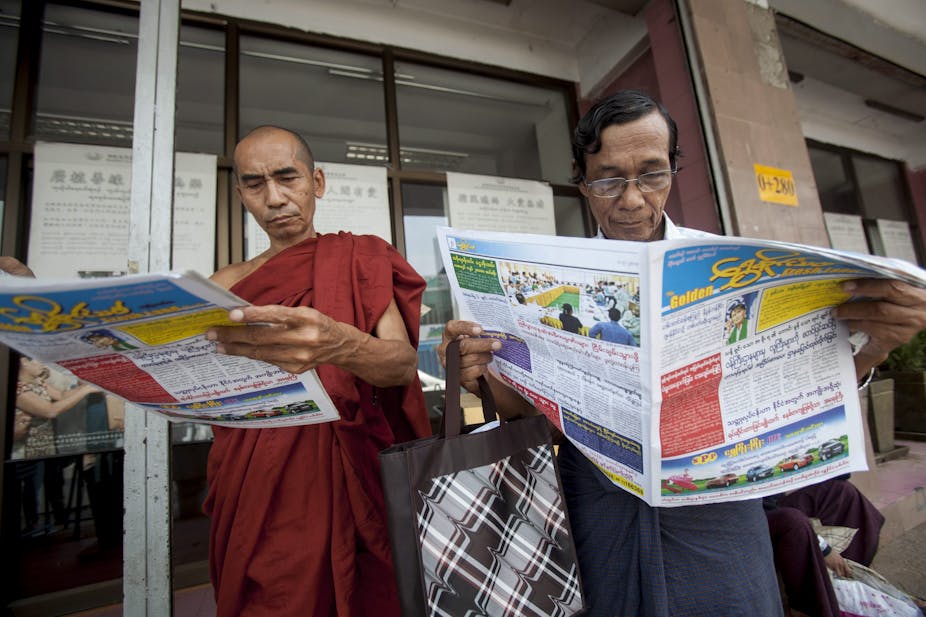A vital aspect of the historic reforms currently underway in Myanmar is the growing - and for some people unexpected - liberalisation of the media.
The latest step in these changes was the appearance on April 1 of privately-owned daily newspapers for the first time in more than fifty years.
The liberalisation of media controls has already allowed Myanmar’s print media to contribute unprecedented space for public policy debate and the contesting of government actions. The Thein Sein government has even found it convenient to use the media directly to encourage discussion of (and hopefully support for) its reform agenda.
Myanmar has had privately-owned weekly news “journals” for several years, one of which is the well known Australian part-owned and operated Myanmar Times: all operating under the previous military regime’s strict censorship.
Journalists accustomed to operating under the strict censorship regime of the time, and fearful of the possible consequences for themselves or their publishers and proprietors, had little option but to practise self-censorship. Before that, the regime of Ne Win (1962-88) closed down private newspapers and in some cases replaced them with government-owned print and broadcasting media.
During the lead-up to the November 2010 elections, Myanmar media provided coverage of opposition party policies for the first time. Since then, Myanmar’s media environment has gradually been liberalised. Myanmar journalists relished the new opportunities they had to cover opposition leader Aung San Suu Kyi’s activities after she was released from detention in November 2010, and a whole industry of National League for Democracy “merchandise” (t-shirts and coffee mugs) was born.
After initially being banned from the proceedings when the new parliament began functioning in 2011, Myanmar’s media soon became prominent in reporting issues being raised by MPs including criticisms of government policies and actions.
Quick to recognise the openings as they occurred after 2011, Myanmar’s media took the lead in publishing reporting on significant events such as the communal violence between Buddhists and Muslims (including the Rohingya) in western Rakhine State and elsewhere.
Protests over allegedly illegal land confiscations (“land grabs”), as well as the fighting between government forces and ethnic groups such as the Kachin Independence Army in the north, were also reported. Indeed, some might see the increased media reporting as a mixed blessing, in that it possibly exacerbated public reactions to perceived threats and activities by minority groups. Persuading Myanmar people to practise greater tolerance and to exercise mutual restraint on occasions - as may be necessary in a democracy - may not be so easy to achieve.
Nevertheless, in August 2012, the Thein Sein government announced that it would no longer be necessary for print media to submit material for censorship in advance. In January 2013, the government’s notorious Press Scrutiny and Registration Division was abolished. During 2012, many but not all of the journalists held in prison – in effect, as political prisoners – were released.
In addition, representatives from the previously exiled Burmese media were allowed to visit Myanmar, having been “blacklisted”. Consistent with the more inclusive approach being pursued by the new government, prominent expatriate media groups such as Mizzima (based in New Delhi) and Democratic Voice of Burma (based in Norway) were allowed to open offices inside Myanmar.

Freedom of expression is guaranteed under the 2008 Myanmar constitution, but until now little had been done in terms of new laws or regulatory arrangements to give effect to this “freedom”. A new media law is now in preparation to reflect the new liberalised political environment, but a draft, prepared by the Ministry of Information, has been criticised for being too restrictive.
Meanwhile, repressive laws such as the 2004 Electronic Transactions Law, the 1962 Printers and Publishers Registration Law, as well as the 1975 State Protection Law (under which journalists have been charged and imprisoned), remain in place.
At present, media reforms are limited to the print media, with broadcast media still largely government-owned and controlled. A few new private community FM radio stations have been established in larger cities, but otherwise the people of Myanmar still look to international short-wave broadcasters operating Burmese language services, such as the BBC, Voice of America and Radio Australia for radio news.
Similarly, international satellite television services substitute for free television broadcasting, as access to them is hard for the authorities to control. The internet is still irregular and officially controlled, however, with access and content closely monitored.
Foreign journalists are now allowed greater freedom to report from Myanmar than in the past, but there is still no move to allow foreign correspondents other than those from China’s Xinhua newsagency to be based in Myanmar. International news agencies such as Reuters, Associated Press, Agence France-Presse and some Japanese agencies rely on highly capable local journalists working courageously as “stringers” (self-employed freelance journalists), and always at risk of incurring the wrath of the authorities.
Media freedom in Myanmar has dramatically and rapidly improved, and is an integral place in the reforms occurring in the country. But media freedom in Myanmar is unfinished business, and is still not fully secured.

